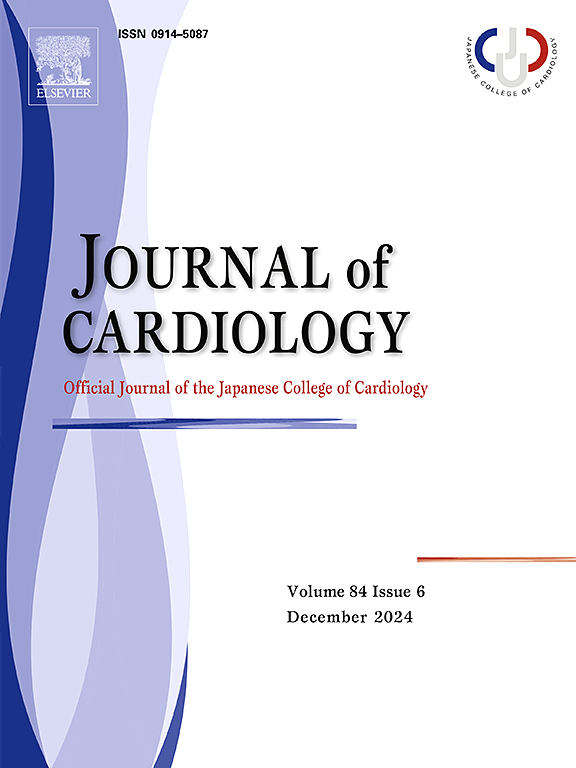Prognostic values of proteinuria in patients with acute heart failure
IF 2.5
3区 医学
Q2 CARDIAC & CARDIOVASCULAR SYSTEMS
引用次数: 0
Abstract
Background
Renal dysfunction is significantly associated with poor prognosis in patients with heart failure. However, the prognostic significance of proteinuria as a potential marker of an impaired glomerular filtration barrier in acute heart failure (AHF) remains unclear. We aimed to investigate the prognostic value of urinary protein/creatinine ratio (PCR) in patients with AHF.
Methods
Urinary protein levels measured at admission were adjusted for urinary creatinine concentrations in 346 patients (75 ± 13 years; 61 % men) with AHF. Patients were categorized based on urinary PCR, adhering to the Japanese chronic kidney disease (CKD) guideline cut-offs for CKD staging: A1 (<0.15 g/gCr), A2 (0.15–0.49 g/gCr), and A3 (≥0.5 g/gCr). The primary endpoint was all-cause mortality.
Results
Overall, there were 85, 126, and 135 patients in the A1, A2, and A3 groups, respectively. Groups A2 and A3 were associated with lower hemoglobin levels, higher blood urea nitrogen and N-terminal pro-B-type natriuretic peptide levels, and poor renal function. Moreover, groups A2 and A3 had high cystatin C, alpha 1 microglobulin, and urinary liver-type fatty acid-binding protein (L-FABP) levels. Urinary PCR correlated more with tubular markers, alpha 1-microglobulin, and L-FABP than with the glomerular marker cystatin C. Over a median follow-up period of 434 (interquartile range: 89–753) days, 72 deaths occurred. Elevated urinary PCR was associated with higher mortality rates (log-rank test, p < 0.001), even after adjusting for other variables [A2 vs. A1: hazard ratio (HR) 2.59, 95 % confidence interval (CI) 0.71–9,55, p = 0.15; A3 vs. A1: HR 4.40, 95 % CI 1.17–16.6, p = 0.029].
Conclusions
Elevated urinary PCR is more prevalent in patients with AHF and is associated with a higher risk of all-cause mortality, independent of covariates, including glomerular function. Thus, urinary PCR at admission should provide prognostic information independent of glomerular function.

急性心力衰竭患者蛋白尿的预后价值。
背景:心力衰竭患者肾功能不全与预后不良显著相关。然而,蛋白尿作为急性心力衰竭(AHF)肾小球滤过屏障受损的潜在标志物的预后意义尚不清楚。我们的目的是探讨尿蛋白/肌酐比值(PCR)在AHF患者中的预后价值。方法:对346例患者(75 ± 13 年;61 %男性)AHF。根据尿PCR对患者进行分类,并遵循日本慢性肾脏疾病(CKD)指南对CKD分期的截止值:A1(结果:总体而言,A1、A2和A3组分别有85、126和135例患者。A2和A3组血红蛋白水平降低,血尿素氮和n端前b型利钠肽水平升高,肾功能不佳。此外,A2和A3组胱抑素C、α 1微球蛋白和尿肝型脂肪酸结合蛋白(L-FABP)水平较高。尿PCR与肾小管标志物、α 1微球蛋白和L-FABP的相关性大于与肾小球标志物胱抑素c的相关性。在434天(四分位数间距:89-753)的中位随访期间,发生了72例死亡。尿PCR升高与较高的死亡率相关(log-rank检验,p )结论:尿PCR升高在AHF患者中更为普遍,且与包括肾小球功能在内的协变量相关的全因死亡率风险较高。因此,入院时的尿PCR应提供独立于肾小球功能的预后信息。
本文章由计算机程序翻译,如有差异,请以英文原文为准。
求助全文
约1分钟内获得全文
求助全文
来源期刊

Journal of cardiology
CARDIAC & CARDIOVASCULAR SYSTEMS-
CiteScore
4.90
自引率
8.00%
发文量
202
审稿时长
29 days
期刊介绍:
The official journal of the Japanese College of Cardiology is an international, English language, peer-reviewed journal publishing the latest findings in cardiovascular medicine. Journal of Cardiology (JC) aims to publish the highest-quality material covering original basic and clinical research on all aspects of cardiovascular disease. Topics covered include ischemic heart disease, cardiomyopathy, valvular heart disease, vascular disease, hypertension, arrhythmia, congenital heart disease, pharmacological and non-pharmacological treatment, new diagnostic techniques, and cardiovascular imaging. JC also publishes a selection of review articles, clinical trials, short communications, and important messages and letters to the editor.
 求助内容:
求助内容: 应助结果提醒方式:
应助结果提醒方式:


